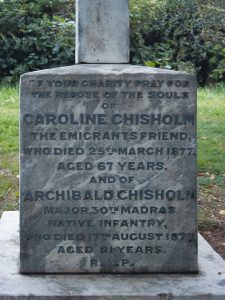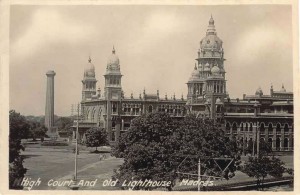Caroline Chisholm – Northampton’s half-forgotten saint.
Catholic Mission’s UK reporter Sister Janet Fearns went searching for Caroline Chisholm’s last resting place. She discovered a little corner in a disused cemetery and the ignorance of England’s Catholics of Australia’s saint-in-waiting’s achievements
Three local people gave the same answer when asked for the whereabouts of the Billing Road Cemetery. “I didn’t know that there is a cemetery on this road. I’m sorry that I can’t help you.”
The difficulty was that this repeated dialogue took place on Northampton’s Billing Road and the cemetery turned out to be less than a half-mile ahead. As it happened, people could be excused for not knowing of the graveyard’s existence. Opened in 1847 it closed after its owners, the General Cemetery Corporation apparently went bankrupt in the 1940s. The few graves are scattered in an apparently random fashion, and include less than 150 burials from both World War I and II.
In a corner of the cemetery, marked by a white marble cross which has seen better days and honoured by a purple plastic chrysanthemum stuck into the soil, lies Caroline Chisholm, ‘The Emigrant’s Friend’. She lies with her husband, Archibald who died on 17 August 1877, aged 81, within five months of his wife’s death. The inscription on the tombstone reads, ‘Of your charity pray for the repose of the souls of Caroline Chisholm... and of Archibald Chisholm...’
Little did mourners realise that, a century later, a nation would pray through Caroline and seriously hope for a miracle to promote her cause for canonisation. Perhaps the semi-neglected grave merely shows the world that in death, as in life, neither Caroline nor Archibald made any effort to trumpet their good deeds to the world. A leaflet in the back of the now Anglican Church of the Holy Sepulchre included a small photograph of the woman whom many Catholic Australians consider their ‘next’ saint now that Mary MacKillop has been canonised. Perhaps it is significant that although the Australian Church promotes Caroline to the world ‘as worthy of imitation’, in her native Northampton, she is the half-forgotten saint. Caroline is recalled on a banner and leaflet at the entrance to the Anglican church in which she was baptised and married, whilst the Catholic cathedral from where she was buried, is silent.
Her image marked the Australian $5 bill for 25 years, the first women who was not a monarch to appear on Australian currency. Perhaps the reason why Caroline Chisholm is so little known in her own country has something to do with being both a woman and a Catholic in England before the passing of the Catholic Emancipation Act and the seemingly interminably slow recognition of women’s achievements in a male-dominated society.
The youngest of a large family and the daughter of a land owner and pig farmer, Caroline was born on 30 May 1808 in Wootton, a small town about 3 miles from Northampton. Her father, William Jones, appears to have been a generous man, eager to set his children a personal, committed and practical example of concern for the welfare of others.
In 1830, Caroline married Captain Archibald Chisholm of the East India Company, 13 years her senior, a Catholic and a Scot, in the church of the Holy Sepulchre in Northampton. She became a Catholic at about the same time.
Archibald was posted to Madras in 1832. Joining him one year later, she was horrified to see that although the children of army officers received every advantage, those of the ordinary soldier were neglected by the authorities and often lived in dire poverty. Many wives and daughters resorted to crime and prostitution in order to make ends meet. Determined to help, in 1834, with assistance from the Governor of Madras, Caroline founded the Female School of Industry for the Daughters of European Soldiers. This provided a basic education in religion, literacy, cooking, housekeeping and nursing. However her students were not to have merely abstract lessons in mothercraft. They acquired hands-on, practical experience of childcare when Caroline started the world’s first ever crèche.
In 1838, Archibald was granted leave and the family moved to Sydney, Australia, where Caroline remained with their three sons when her husband was recalled to active service in India. The colonisation of Australia began in 1788 when it was established as a penal colony and convict labour was cheap and economically sustainable. Fifty years later, when the Chisholm family arrived, the number of voluntary settlers was rapidly increasing, but their new home was still in its infancy and far from providing a stable, secure and morally upright community. Sydney was still a convict colony in which men vastly outnumbered women and where young women in search of a new life found little or no chance of a home and a steady income. In their poverty, many were easy prey for pimps. Others were convicts or former convicts who returned to crime in order to survive a life without hope, future or family. Initially Caroline tried to help these women find work, sheltering some in her home.
As Britain encouraged the migration of young women to Australia in order to redress the gender imbalance, she met every ship and tried to ensure that the girls were well-treated, even going so far as to start a type of marriage agency for their protection. Eventually, with the help of the Governor, Sir George Gipps, Caroline obtained and renamed a former immigration hostel as the Female Immigrants Home. Through this project, she gave women and girls somewhere to live, found work for them or placed them with established families.
Caroline saw for herself the desperate loneliness and homesickness which exacerbated the problems in Sydney. Without the comfort and support of their families in England many convicts and former convicts only returned to crime and prostitution. On her return to England in the 1840s, Caroline campaigned for free passage to Australia for these families and for an improvement to their appalling shipboard conditions, being the prime mover in the passing of the Passenger Act of 1852. She even ensured decent conditions by chartering her own ships with a doctor to oversee the diet of the passengers. Where free passage was unavailable, her Family Colonization Loan Society offered loans which required repayment within two years of arrival in Australia. In her efforts to gain support for the venture, Caroline toured Britain, Germany, France and Italy, where she met Pope Pius IX.
The goldrush in towns like Ballarat and Bendigo led to further family breakdown, violence, poverty, greed and degradation in its accompanying hunger to ‘get rich quick’. Caroline returned to Australia in 1854, heading straight to the goldfields to set up shops for the gold diggers and, with Government support, constructing decent shelters to replace the hovels in which most lived whilst panning for ‘yellow metal’. Once again, migrant families headed her agenda. If land could be made available, sustainable farming could replace the frequently frustrated hopes associated with gold mining. However, families also need schools and hospitals. No problem. Caroline campaigned for and also started schools and hospitals throughout Australia.
Eventually having eight children of their own, Caroline and Archibald moved to Sydney in 1857, and back to England in 1866. The ‘Emigrants’ friend’ died in poverty in Highgate, London, perhaps unsurprisingly on the feast of the Annunciation, on 25 March 1877, after a life poured out for others. Caroline was buried in her home town of Northampton and, five months later, Archibald, her husband and unfailing support, was buried alongside her.
Sister Janet Fearns FMDM is a Franciscan who works as a media officer for Catholic Mission in the UK
Printed with permission of Catholic Mission, Australia


 Entries(RSS)
Entries(RSS)